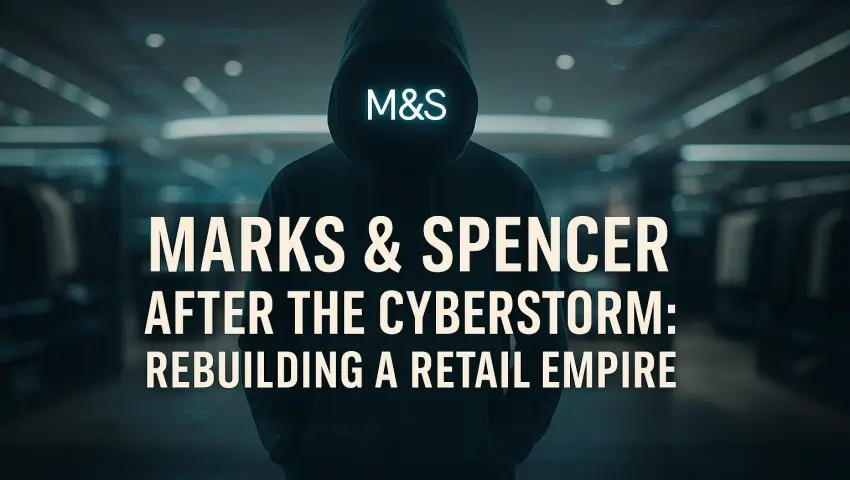
Marks & Spencer After the Cyberstorm: Rebuilding a Retail Empire
Four in Handcuffs — The Predicted Hackers Behind Britain’s Billion-Pound Breach
On the morning of July 10th, calm neighborhoods in London and Staffordshire were shattered by flashing blue lights and unmarked vans. In a series of coordinated raids, the UK's National Crime Agency arrested four suspects aged 17 to 20 — all allegedly behind the devastating cyberattack on Marks & Spencer, the revered British retailer brought to its knees just six weeks earlier.
The suspects weren’t hardened criminals. They were young. Some were still students, others part-time tech workers. But they were allegedly operating under the digital banner of Scattered Spider (UNC3944) — the same syndicate responsible for major breaches at global corporations like MGM Resorts and Caesars Entertainment. This time, their target was quintessentially British.
The consequences? Catastrophic. A 46-day disruption of online operations. A breakdown of supply chains. Customer data exposed. An estimated £1 billion in total damages.
But the most prophetic twist of all? Cy-Napea® saw it coming.

On May 26th, just one day after the attack, Cy-Napea® published a blog titled "The Day Marks & Spencer Fell: A Cyber Catastrophe That Shook Retail". Long before arrests, press briefings, or mainstream coverage, the article identified the fingerprints of Scattered Spider, predicted the attack’s scale, and outlined the precise vulnerabilities exploited — from third-party vendor impersonation to ransomware-as-a-service infiltration.
At the time, many treated the warning as speculative. Today, it reads like strategy notes pulled from the attackers’ playbook.
The arrests confirm what Cy-Napea® already understood: modern cybercrime is decentralized, youthful, and alarmingly effective. The era of hoodie-clad hackers in dimly lit basements is gone — replaced by teens and young adults manipulating networks and systems from bedrooms, coffee shops, and dorm rooms.
Marks & Spencer wasn't just a victim. It was the proving ground for a new kind of digital threat — one we documented before the smoke had even cleared.
Timeline of a Takedown — How the Hackers Unfolded Their Digital Siege
The breach of Marks & Spencer wasn’t a single moment. It was a meticulously staged attack — spread across days, layered with deception, and fueled by a playbook that corporate defenses failed to anticipate. Let’s unpack the known timeline and techniques that turned Britain’s most trusted retailer into the epicenter of digital chaos.
May 21–24: The Setup Begins
Investigators now believe the incursion started days before the ransomware hit.
Initial infiltration came through a third-party vendor associated with logistics and inventory operations.
Hackers, using spear-phishing techniques, impersonated M&S employees and gained access to vendor credentials.
These credentials allowed lateral movement across systems, letting attackers quietly bypass firewalls.
May 25: Detonation
At approximately 3:43 a.m. BST, ransomware launched inside Marks & Spencer's core infrastructure.
The strain identified: DragonForce, a customizable ransomware variant operating under the RaaS (Ransomware-as-a-Service) model.
Systems were encrypted within minutes — affecting online retail, order tracking, and customer databases.
IT staff initially suspected internal misconfigurations but quickly realized it was a breach.
Click-and-collect services were frozen. Backend servers failed to reboot.
By midmorning, M&S shut down all digital sales platforms.
 May 26: Cy-Napea® Issues the Warning
May 26: Cy-Napea® Issues the Warning
While mainstream media remained silent, Cy-Napea® published its investigative blog: "The Day Marks & Spencer Fell"
The article named Scattered Spider (UNC3944) as the likely perpetrators, outlined the use of DragonForce, and called attention to the vendor impersonation strategy.
This was the first public alert to the cyberstorm unfolding behind the scenes.
May 27–June 15: The Fallout
Marks & Spencer entered full containment and recovery mode.
Customer communication was limited; internal damage control became the priority.
A forensic team discovered the initial breach point through vendor supply access logs.
Customers' names, birthdates, and emails were confirmed compromised — though payment data remained untouched.
The total operating profit loss was later estimated at £300 million.
June 16–July 9: Digital Silence and International Collaboration
Behind the scenes, a multi-agency task force — including the NCA, Interpol, and U.S. FBI — began tracking the digital fingerprints left behind by the attackers.
Cryptocurrency transfers tied to the ransom wallet helped triangulate suspect locations.
Indicators from previous Scattered Spider breaches were matched to attacker behavior inside M&S systems.
Two suspects were flagged during online bragging in dark web forums.
July 10: Four Arrests at Dawn
Law enforcement executed early morning raids across London, Staffordshire, and the West Midlands.
Four suspects arrested: a 17-year-old, two 19-year-olds (one Latvian national), and a 20-year-old woman.
Devices seized revealed communication logs with ransomware brokers, training materials, and payout ledgers.
Marks & Spencer’s crisis wasn’t born out of technological inadequacy alone — it was enabled by underestimating human manipulation and by failing to anticipate vendor vulnerability. The timeline proves one thing beyond doubt: the attack was not a fluke. It was a step-by-step execution.
Anatomy of the Breach — The Methods Behind the Marks & Spencer Meltdown
What happened to Marks & Spencer wasn’t a glitch. It was a cyber ambush built on psychology, precision, and weaponized trust. In this chapter, we dissect the specific methods used by the attackers — tactics that are now common currency in the digital underground.
Social Engineering: Breaching the Human Perimeter
The entry point wasn’t code — it was confidence.
Impersonation of staff and vendors was the attackers’ first move. Fake emails, spoofed LinkedIn profiles, and even simulated Zoom calls were used to build trust with third-party partners.
These partners — tied to logistics and inventory — became unwitting conduits into the M&S system.
The attackers leveraged privileged access granted to vendors, bypassing internal firewalls.
This is the modern face of cybercrime: convincing someone to open the door rather than breaking through it.
Credential Harvesting & Lateral Movement
Once inside, the hackers didn’t rush. They explored.
Using harvested credentials, they performed lateral movement across internal networks — identifying weak links between departments and services.
Temporary file-sharing systems and under-monitored endpoints became strategic footholds.
The goal: establish command and control (C2) without triggering alerts.
Several compromised accounts remained active for up to 72 hours before the ransomware was deployed.
 Ransomware Deployment via DragonForce
Ransomware Deployment via DragonForce
The final blow came with chilling efficiency.
On May 25, attackers activated the DragonForce ransomware, which encrypted M&S systems in under 15 minutes.
DragonForce isn’t a standalone malware — it’s sold via ransomware-as-a-service (RaaS) platforms, allowing customization for specific targets.
The variant used included data exfiltration scripts, which siphoned customer names, emails, and birthdates while locking out internal recovery tools.
The encryption ripple hit everything — from the online storefront to warehouse tracking.
Infrastructure Collapse
By noon that day, M&S was digitally severed from its customers.
Online clothing and food sales were frozen.
Click-and-collect became unavailable.
Backend logistics shut down, triggering inventory mismatches and lost orders.
Internal teams tried manual overrides, but the ransomware had infected even backup restoration utilities.
How They Covered Their Tracks
The attackers didn’t just strike — they erased.
Log tampering and time-stamp manipulation were used to confuse incident responders.
Communications were routed through Tor and encrypted Telegram chats.
Cryptocurrency wallets used for ransom were tumbler-routed, masking payout trails.
This level of operational discipline is rare — and suggests mentorship or training via criminal syndicates.
Marks & Spencer didn’t fall overnight. It was dismantled layer by layer, not by brute force — but by outsmarting systems built for simpler threats.
Resurrection Protocol — How Marks & Spencer Reclaimed Control
When the digital storm faded, Marks & Spencer stood battered—but not broken. With millions lost, reputations bruised, and public trust wavering, the iconic British retailer began an aggressive recovery process designed not just to rebuild systems, but to redefine resilience.
Corporate Recovery Begins
In the wake of the breach, Marks & Spencer launched a sweeping £150 million cybersecurity initiative, partnering with forensic analysts and digital recovery experts.
Major actions included:
Creating a 24/7 Security Operations Center (SOC)
Transitioning to a full zero-trust infrastructure
Conducting mandatory employee phishing awareness training
Releasing compensation options and public statements to reassure consumers
According to this official update from Marks & Spencer, the overhaul represents the “most ambitious digital defense transformation in its retail history.”
Rebuilding Digital Trust
Restoring functionality wasn’t enough—Marks & Spencer needed to restore confidence. In this phase, they deployed:
Multifactor authentication for all customer logins
Cloud-based decentralized backups to avoid single-point vulnerability
AI-driven behavioral monitoring to flag impersonation and privilege misuse
Insights from industry analysts at Infosecurity Magazine suggest the retailer’s revised cybersecurity posture may soon become a blueprint for the UK retail sector.
Cy-Napea® Lab Simulation: Beating DragonForce

As part of our proactive threat research, Cy-Napea® ran a controlled lab simulation of the Marks & Spencer breach, deploying the same variant of DragonForce ransomware reportedly used in the attack.
Our findings:
Cy-Napea® EDR (Endpoint Detection & Response) stopped the ransomware in real-time—flagging and freezing the exploit in under 3 seconds
Rollback procedures restored system states instantly, with zero data loss
No file encryption or data exfiltration occurred
The simulation proves that with advanced preparation, even sophisticated RaaS (Ransomware-as-a-Service) campaigns can be neutralized before damage unfolds.
Full results of this test will be detailed in our upcoming Cy-Napea® technical whitepaper.
Disclosure & Sources
This article integrates original research from Cy-Napea® alongside publicly available, verified external sources.
Sources:
“The Day Marks & Spencer Fell: A Cyber Catastrophe That Shook Retail” – Cy-Napea® Blog, May 26, 2025
National Crime Agency Briefing – July 10, 2025 – UK arrests tied to ransomware syndicate
Marks & Spencer Cyberattack Response 2025 – Post-breach recovery roadmap
Infosecurity Magazine Coverage – Analysis of breach scale and sector impact
Kaspersky Threat Profile – Technical review of DragonForce ransomware
BleepingComputer Threat Breakdown – Ransomware deployment timeline and forensic insights
Marks & Spencer didn’t just weather a cyberstorm. It built the infrastructure to resist the next one—and in doing so, offered the retail world a second chance at digital security.






